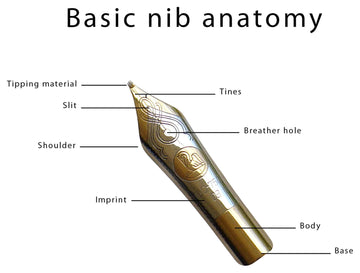Welcome to our comprehensive guide on understanding fountain pen nibs. Fountain pens are more than just writing tools; they offer a unique and personalized writing experience. The nib is a crucial component that influences the aesthetics, comfort, and flow of your strokes. In this guide, we will delve into the world of fountain pen nibs, helping you make informed decisions when choosing a pen that suits your writing style and preferences.
Nib Anatomy and Sizes
Fountain pen nibs come in various sizes, ranging from Extra Fine (EF) to Double Broad (BB). The size of the nib determines the width of the line it creates on paper. A fine nib, for instance, produces a thin and precise line, perfect for general writing, note-taking, and drawing details. On the other hand, a broad nib creates a wider, bolder line, ideal for headings, signatures, or artistic expression. It's important to note that ink flow can also affect line width, as thicker inks tend to produce wider lines.
Nib Materials
Nibs are primarily made from steel and gold, each offering different benefits. Steel nibs are typically more affordable, durable, and accessible to beginners. Gold nibs, on the other hand, often provide smoother writing experiences and are less prone to wearing out over time. Some manufacturers also offer nibs made of other materials like palladium or titanium, each having unique properties and writing characteristics.
Tip Shapes and Flexibility
Nibs come in a variety of tip shapes, including round, stub, italic, and flex nibs 4. Round tips provide consistent line widths and are the most common 4. Stub tips have a flat, wider tip, creating a distinct line variation between horizontal and vertical strokes. Italic tips have an even flatter, broader tip with a sharp edge, generating a bold and distinctive handwriting style. Flex nibs are designed to provide line variation based on pressure, allowing for expressive writing and artistic flourishes.
Regional Differences and Specialty Options
Regional differences can impact nib design and performance. Japanese nibs are known for their fine lines, precision, and smoothness. European nibs are often associated with bold lines and distinctive tip shapes. Some manufacturers also offer specialty nibs, like music nibs for composers or calligraphy nibs for artists.
Care Tips
Proper care can extend the lifespan and enhance the performance of your fountain pen nib. Regular cleaning, flushing, and adjustments are essential. Be mindful of the ink you use, as some inks may be too thick for certain nibs or cause clogs. Avoid applying excessive pressure on your nib, which can lead to damage and reduce its flexibility.
Summary
Understanding fountain pen nibs is crucial for choosing the right pen for your writing needs. By familiarizing yourself with nib anatomy, sizes, materials, tip shapes, flexibility, regional differences, specialty options, and care tips, you can make informed decisions and enjoy a personalized writing experience. Whether you're a seasoned fountain pen enthusiast or a curious beginner, our comprehensive guide will help you explore the world of fountain pen nibs and uncover the perfect pen for you.
Nib Anatomy and Sizes
Fountain pen nibs come in various sizes, ranging from Extra Fine (EF) to Double Broad (BB). The size of the nib determines the width of the line it creates on paper. A fine nib, for instance, produces a thin and precise line, perfect for general writing, note-taking, and drawing details. On the other hand, a broad nib creates a wider, bolder line, ideal for headings, signatures, or artistic expression. It's important to note that ink flow can also affect line width, as thicker inks tend to produce wider lines.
Nib Materials
Nibs are primarily made from steel and gold, each offering different benefits. Steel nibs are typically more affordable, durable, and accessible to beginners. Gold nibs, on the other hand, often provide smoother writing experiences and are less prone to wearing out over time. Some manufacturers also offer nibs made of other materials like palladium or titanium, each having unique properties and writing characteristics.
Tip Shapes and Flexibility
Nibs come in a variety of tip shapes, including round, stub, italic, and flex nibs 4. Round tips provide consistent line widths and are the most common 4. Stub tips have a flat, wider tip, creating a distinct line variation between horizontal and vertical strokes. Italic tips have an even flatter, broader tip with a sharp edge, generating a bold and distinctive handwriting style. Flex nibs are designed to provide line variation based on pressure, allowing for expressive writing and artistic flourishes.
Regional Differences and Specialty Options
Regional differences can impact nib design and performance. Japanese nibs are known for their fine lines, precision, and smoothness. European nibs are often associated with bold lines and distinctive tip shapes. Some manufacturers also offer specialty nibs, like music nibs for composers or calligraphy nibs for artists.
Care Tips
Proper care can extend the lifespan and enhance the performance of your fountain pen nib. Regular cleaning, flushing, and adjustments are essential. Be mindful of the ink you use, as some inks may be too thick for certain nibs or cause clogs. Avoid applying excessive pressure on your nib, which can lead to damage and reduce its flexibility.
Summary
Understanding fountain pen nibs is crucial for choosing the right pen for your writing needs. By familiarizing yourself with nib anatomy, sizes, materials, tip shapes, flexibility, regional differences, specialty options, and care tips, you can make informed decisions and enjoy a personalized writing experience. Whether you're a seasoned fountain pen enthusiast or a curious beginner, our comprehensive guide will help you explore the world of fountain pen nibs and uncover the perfect pen for you.





